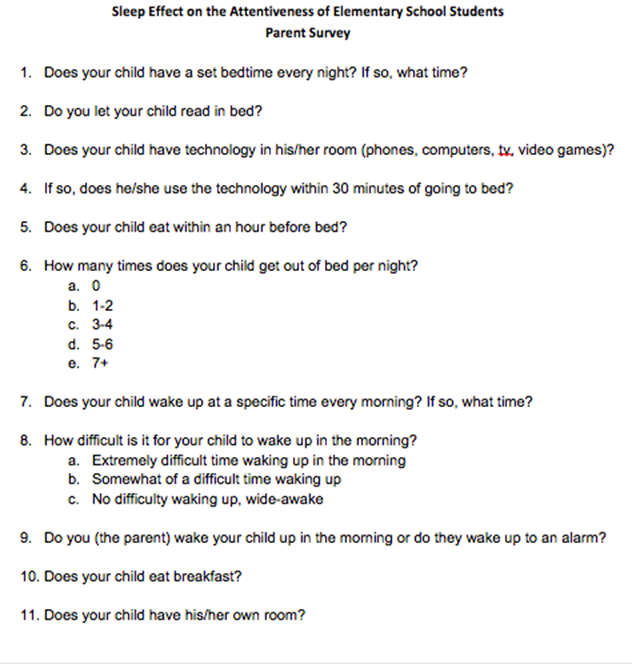Effect of Sleep on the Attentiveness of Elementary School Students
Haynes, K., Virgin, K., Wilson, M., & Crecelius, A.
Abstract
Sleep is known to be important in the development of children and their cognitive functioning. This study worked to establish correlation between amount of sleep and attentiveness in school-aged children. This study surveyed the parents of 10 third graders on their child’s sleep habits. The children were read a story in class and asked to answer questions based on details in the story. The data obtained from this quiz and the parent’s survey responses were then compared to see if there was a relation. The results of this study were inconclusive. When genders were separated, it was found that males slept the most but females got more answers correct on the quiz. However, when the data was organized based on the recommended sleep amount for this age, it was found that children who met the recommendation answered more questions correctly compared to those who did not.
Introduction
Many factorscan potentially affect attentiveness in school including: learning disabilities, teacher effectiveness, class size, classroom distractions, student motivation, and sleep time of students (McDowell et al., 1980; Witt, 1986). This study focuses specifically on sleep duration and its effect on attentiveness in school children.
Amount of sleep obtained by students has been shown to directly influence attentiveness and memory function (Matricciani et al., 2012; Terman et al., 2012). However, there is limited research showing how the amount of sleep affects children’s attention and retention of information in the school setting specifically. This study was designed to test if there is a correlation between amount of sleep and attentiveness in third grade elementary school students.
Children from the ages of 8-9 years old are recommended to get 10.5 hours of sleep (Matricciani et al., 2012). According to a meta-analysis conducted by Dewald et al., 45% of adolescents sleep less than 8 hours per night, which is well below the recommended amount (2009). This lack of sleep could potentially cause problems related to learning, memory, and school performance (Matricciani et al., 2012; Terman et al., 2012). Although adequate sleep time has been shown to increase children’s school performance, there has also been contradictory research showing that sleep time and concentration in children have no relationship (Meijer et al., 2000).
On the basis of evidence generated by the majority of the previous research described, it was hypothesized that there will be a direct relationship between the amount of sleep school children obtain and attentiveness in the classroom.
Methods
Subjects
The subjects included a convenience sample of third grade students (N=10) from a small private school in Xenia, Ohio. The sample included an equal number of male subjects (N=5) and female subjects (N=5). This study was approved by the Institutional Review Board at the University of Dayton. Students were required to submit parental consent prior to participation and also gave written assent.
Instrumentation
Data were collected from students using two instruments. Included was a survey sent home to the parents of the children, where they were asked to give information on their children’s sleeping habits (Appendix A). The 11 questions used in the survey were investigator-created. The only data from this survey that was used in the data analysis was the amount of hours each of the children slept per night.
The other 10 questions were used to collect additional descriptive data about student sleep characteristics. These were used to establish baseline data for future studies on this topic. We also utilized a quiz that was used to analyze the students’ attentiveness. Each student completed the quiz during a class period. The two instruments are original and were created by the researchers, but were based on instruments used in previous studies (Touchette, et al., 2007). The data from the two instruments were combined in order to see the relation between sleep and attentiveness.
Procedures
Permission was first obtained from the parents for their child’s participation in this study. The parents were given a questionnaire that was intended to find out information about their sleeping habits and quality of sleep the night before their child’s attentiveness was to be evaluated. This survey took about 10 minutes to complete. After the parent’s questionnaire had been received, the researchers visited the classroom. The classroom teacher read a short story to the children. After listening to the reading, the children took a short quiz about the story. The children were being tested for their attentiveness toward the teacher and the detail to the story. The quiz took about 5 minutes to complete. Completed quizzes and questionnaires were placed in an envelope and taken by the researchers to be analyzed. To protect the students and parents, no identifying information was used in the analysis or presentation of the data. Instead, the students were assigned a number. The master key of which student was assigned which number was kept in a secure location.
Analysis
Data collection instruments were checked for completeness and only those instruments that were fully completed were included in the analysis. Data from the matched instruments were transferred to and analyzed using Microsoft Excel. Means and standard deviations were calculated for descriptive purposes. Correlations were calculated to assess the relationship between student sleep and their attentiveness in class. T-tests were performed to find the significance between all aspects of study, which includes comparisons between attentiveness, sleep, and gender. Level of significance was set at p < 0.05.
Results:
For this study, there were 21 third grade students eligible to participate, 13 boys and 8 girls. 5 male and 5 female students chose to participate in the study. The average bedtime for the males was just after 8:30pm and the average bedtime for the females was 8:30pm (Figure 1). There was a similar trend in the wake-up times with the females waking up 7 minutes before the males, which was 6:27am and 6:34 respectively (Figure 1). Therefore, on average the females reported just over 10 hours of sleep, which was calculated at 10.016 hours, and answered 6.7±1.72 questions correctly (Figure 1). On average the males reported 10.168 hours of sleep and answered 8.1±0.89 questions correctly (Figure 1).
Other variables of interest include, and were asked on the parent survey: if the child has their own room, if they eat breakfast in the morning, if the parents woke the child up, how difficult the child was to wake up, how many times they got out of bed, if they ate one hour before bedtime, if they had technology in their room, if they used technology 30 minutes before bedtime, and if the child was allowed to read in bed. Based on the results of the parent surveys, these factors were very similar among all participants and therefore did not have a large impact on the amount of sleep received, and ultimately, on the correct answers.
The data focused on four aspects, with the main one being the correlation between the calculated amount of sleep that the third grade students received and the number of correct answers they gave after the story. Upon viewing the graph (Figure 2), the data shows that there was a slight positive relationship between the amount of sleep the children received and the correct number of answers, but this was not significantly significant. (Pearson’s R=0.335; p=0.334).
Impact of Sex
The data was also analyzed as to whether males or females got more sleep and how this affected their ability to answer questions and their attentiveness in class. As mentioned above, the male students reported 9.12 more minutes of sleep than female students (Figure 3). The Pearson’s R was found to be 0.677, which is indicative of a relationship between gender and amount of sleep. The male and female data was also used to analyze gender versus the amount of correct answers from the classroom quiz. Unlike what was hypothesized, even though the females received less hours of sleep, they answered 1.4 more questions correctly (Figure 4). Again, the females answered 8.1±0.89 questions correctly, on average, while the males answered 6.7±1.72 questions (Figure 4).
Comparison to Recommended Amounts
The last aspect that the data was used to analyze was the relationship between the correct number of questions compared to if the child met the recommended hours of sleep for third graders. As mentioned before, the recommended number of hours that a third grade student should receive for correct development is 10.5 hours each night. Based on our data, most of the students (N = 6) did not report 10.5 hours each night, while only 4 students reported 10.5 or more hours each night. The maximum number of hours of sleep was 10.83 hours, while the minimum number of hours was 9 hours of sleep. Those students that reported more than 10.5 hours of sleep answered more of the questions correctly; they averaged 7.75±1.89 correct questions, while those students that got less than 10.5 hours of sleep average 7.2±1.29 correct questions (Figure 5).
Discussion:
Our study was aimed at investigating the effects of duration of sleep on attentiveness in elementary school children, specifically third grade students. Most of the existing research has been done on adults and shows that sleep deprivation has an impact on the cognitive function of adults. There have not been many studies done to see how sleep affects the cognitive function of children. (Touchette et al., 2007).
The results of this study showed that gender had no effect on the amount of sleep the students got each night. The average amount of sleep by male participants was 10.168 hours, while the average amount of sleep by the female participants was 10.016 hours. This is only a difference of 0.152 hours. The most probable reason that there was not much difference between the amount of sleep received by the male and female participants is the fact that the participants were so young. Most children of this age group have set bedtimes and set times to wake up in the morning during the school week. This was reflected in the answers on the parent survey, which showed that all the children went to bed around the same time and awoke around the same time the next morning.
The average amount of quiz questions answered correctly by male students was 6.7 questions, while the average amount answered correctly by female students was 8.1 questions. However, since the females actually received slightly less sleep than the males, the larger amount of correct answers cannot be attributed to the amount of sleep. This difference may actually be attributed to different cognitive abilities and scholastic performance between the two genders at that age, which has been demonstrated by previous research that has shown a larger relationship between sleep duration and school performance in studies that included more boys because of different pubertal development between the two genders (Dewald, et al., 2010). In future research, it may be interesting to only complete the study with one gender to control for any gender differences.
As previously stated, the recommended amount of sleep an eight to nine year old child should get is 10.5 hours (Matricciani, et al.). When comparing the amounts of sleep each student received to the amount of sleep recommended for that age group, over half of the subjects were unable to get the recommended amount of sleep. Based on figure 5, the results show that those students who managed to get above the recommended amount of sleep also were able to answer more questions correctly. In comparison, the students who did not receive the recommended amount of sleep answered fewer questions correctly. These results indicate that it might be more important to the cognitive functioning of a child for that child to receive the recommended amount of sleep. However, the difference was very small so further research would need to be conducted to get a conclusive result.
The hypothesis of the study stated that if a child received more sleep, he/she would be expected to have better attentiveness. As figure 2 shows, there was a slight positive trend between the amounts of sleep each child received and the amount of answers that child answered correctly. However, there was no significant correlation, which indicates that the hypothesis was incorrect. Due to the fact that there was a positive trend but no significance, more research needs to be conducted on the topic.
The results of this study do not offer a clear answer to the question of whether or not sleep has an effect on the attentiveness of elementary school children. There were several limitations that could be corrected for in future studies. One limitation was the sample size. With only 10 subjects, the probability of Type II error increases. The results could be shown to be not true in the study while in reality there may actually be a significant effect on the attentiveness due to the amount of sleep. Another limitation was that all the subjects came from the same small Catholic school. This could be a problem because there was not much difference in demographics, which could skew the results. It is more likely that there would be a wider range of demographics in a public school and thus different sleeping habits.
The methodology also could have been stronger. For example, while the parent survey attempted to control for many factors, one of the question asked was whether or not the child gets out of bed at night and how many times. However, this was not accounted for in the total amount of sleep reported by each child, which could be a limitation because if a child got out of bed several times a night, that child might have actually gotten several hours less sleep than another child but the results would show the same amount of sleep for both children. One way this could be corrected is to have the child fill out a survey regarding how many times he/she got out of bed and how long it took that child to fall back to sleep as well as the sleep latency when first going to bed. For future research, it might be interesting to conduct this study with high school students. High school students tend to go to bed at different times due to having different schedules from peers. In addition, high school students would be able to answer the survey about his/her individual sleep habits instead of having the parents answer this survey, so the answers may be more accurate, thus yielding more valid results.
As stated before, previous research has been done with children that was only a study based on one night of sleep and the results were inconsistent. This study was also done based on one night of sleep; so more research should be done covering several nights of sleep for the same children.
Research on the effects of quality and quantity of sleep on attentiveness in elementary school children could provide many results that are useful to parents of school-aged children. It can provide insight into how important getting the correct amount of sleep is to the success of the children in school. More research should be done on this topic. While we did find a slight positive trend, the results of this study were inconclusive.
References:
Dewald, J., Meijer, A., Oort, F., Kerkhof, G., & Bögels, S. (2010). The influence of sleep quality, sleep duration and sleepiness on school performance in children and adolescents: A meta-analytic review. Sleep Medicine Reviews, 14(3), 179-189.
Matricciani, L., Olds, T., Blunden, S., Rigney, G., & Williams, M. (2012). Never Enough Sleep: A Brief History of Sleep Recommendations for Children. Pediatrics, 129(3), 548-556.
McDowell, E., et al. (1980). A Multivariate Study of Teacher Immediacy, Teaching Effectiveness, and Student Attentiveness at the Junior High and Senior High Levels. Institude of Education Sciences.
Meijer, A., Habekothe, H., & Van Den Wittenboer, G. (2000). Time in bed, quality of sleep and school functioning in children. J Sleep Res, 9(2), 145-153.
Terman, L., & Hocking, A. (n.d.). The Sleep Of School Children: Its Distribution According To Age, And Its Relation To Physical And Mental Efficiency. Journal of Educational Psychology,4(5), 269-282.
Touchette, É, Petite, D., Segiun, J., Boivoin, M., Tremblay, R., Montplaisir, J., & Dahl, R. (2007). Associations Between Sleep Duration Patterns And Behavioral/Cognitive Functioning At School Entry. Journal Of Sleep And Sleep Disorders Research, 30(9), 1079-1219.
Witt, A. (1986). Use of Class Time and Student Attentiveness in Secondary Instrumental Music Rehearsals. J of Research in Music Education, 34(1), 34-42.
Tables and Figures:
Figure 1. Mean values of various characteristics of male and female subjects.
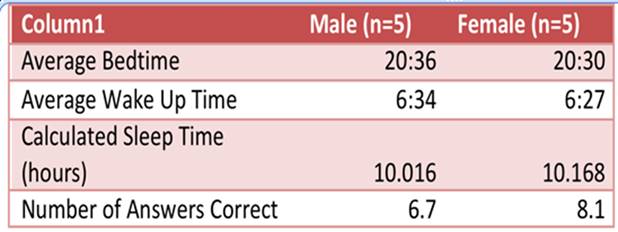
Figure 2. Correct number of answers and calculated amount of sleep.
There is a not significant trend in the correct number of answers and the calculated amount of sleep. There is a slight positive trend, but it is not significant as shown by the R value on the graph.
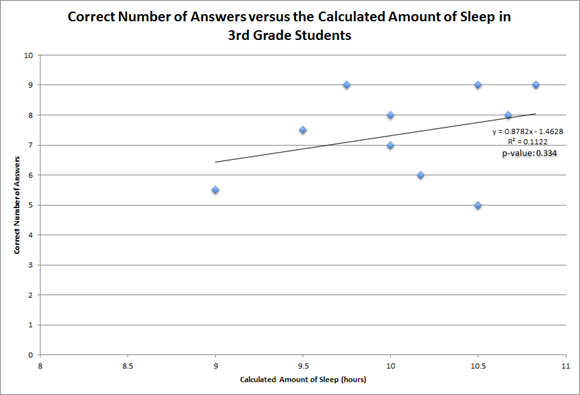
Figure 3. Amount of Sleep in Males versus Females
Male subjects received slightly more sleep than the female students
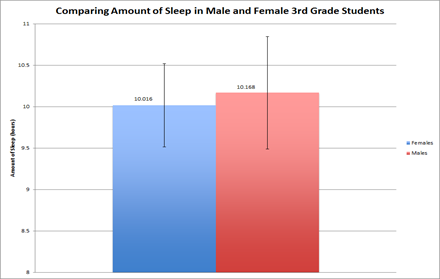
Figure 4. Number of Correct Answers in Males versus Females
Females answered more questions correctly than males, despite having less sleep than males, as shown in Figure 3.
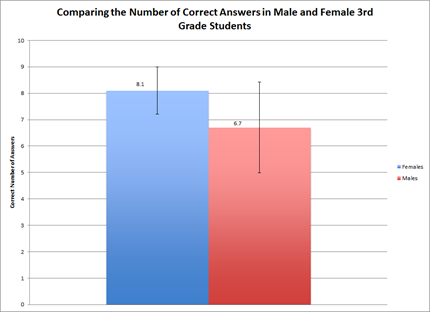
Figure 5. Amount of Correct Questions versus Recommended Hours of Sleep
The recommended amount of sleep for children aged 8-9 is 10.5 hours. Subjects who received less than the recommended amount of sleep answered less questions correctly than those who received equal to or greater than 10.5 hours.
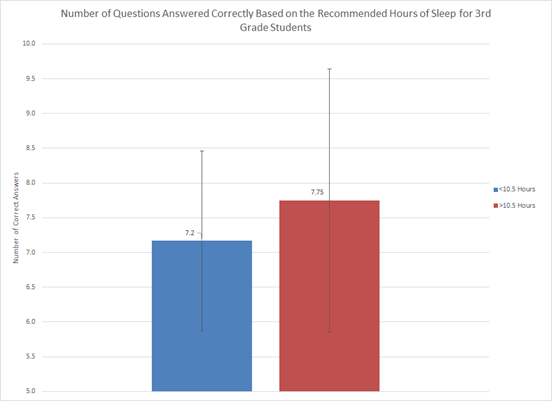
Appendix A. Parent Survey administered prior to data collection.
